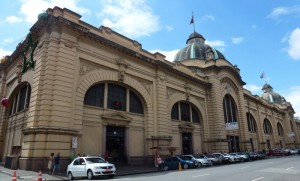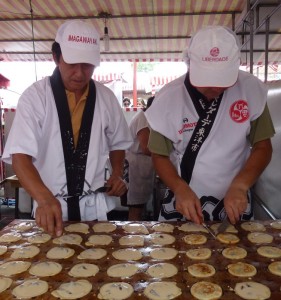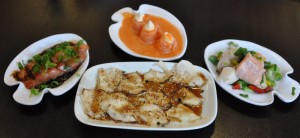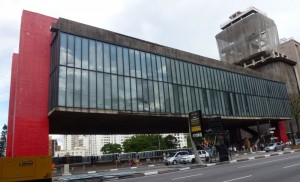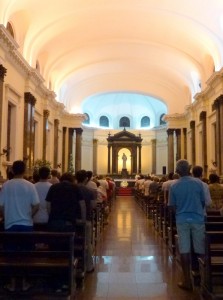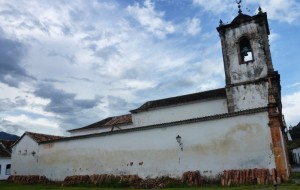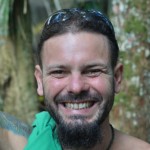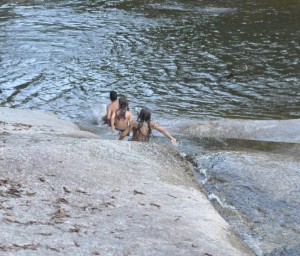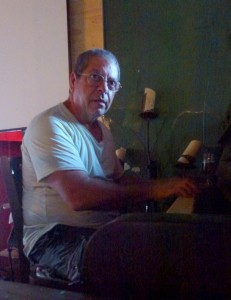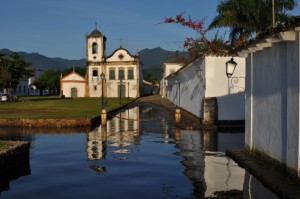Brazil, host of the 2014 World Cup is one of the hottest destinations. Boasting a 7,500km coastline, spectacular landscapes from sandy beaches to Amazon rainforest, carnivals with dance, music and exquisite costumes, and a unique mix of peoples and cultures, Brazil should be on everyone’s bucket list.
Introduction
Brazil is the world’s fifth largest country by geographic area (8,456,000 km²) and by population (about 200 million in 2010). Occupying 47% of South America, Brazil borders all countries in the continent except Chile and Ecuador.
Portuguese explorer Pedro Álvares Cabral first arrived in Brazil in 1500 and claimed the land for Portugal. African slaves were brought to work on sugar plantation and later gold mines. An estimated number of 3.5 million slaves arrived before abolition of slavery in 1888.
Brazil was Portugal’s colony for over 300 years and gained independence without a war. During the Napoleonic War, the Prince Regent (later known as Dom João VI) transferred his court to Brazil in 1807. When he became king, Rio de Janerio was made the capital of United Kingdom of Portugal and Brazil. When he returned to Portugal in 1821, he left his son Pedro in Brazil as regent. Pedro declared independence in 1822 when the Portuguese parliament attempted to return it to a colony and crowned himself as Emperor Dom Pedro I. In 1889, the empire was toppled following a military coup and Brazil became a presidential republic with a constitution following the United States´ example.
For the next 40 years, the country was governed by a series of military and civilian presidents but it was the armed forces that effectively ruled the country. In 1930, the military seized power and installed Getúlio Vargas who lost the election as President. Vargas committed suicide in 1954 when he was forced to step down by the military. Eventually, a military junta led the country from 1964 to 1985. Brazil became a federal republic following the adoption of a new constitution in 1988 and has since been ruled by more democratic and stable governments.
Brazil has been a melting pot of ethnic groups and cultures. Some five million people migrated to Brazil between 1808 and 1972 and most of them were of Portuguese, Italian, German, Polish, Jewish, Russian, Japanese and Chinese origins. About 47.7% of the population is white, 43% Pardo, 7.6% black and 1% Asian (2010 statistics). Its culture has therefore been shaped by the Portuguese, the indigenous population, the Africans and immigrants. Catholicism is the predominant faith (65% of the population) followed by Protestantism (22%).
The country has vast resources and wealth and has been the leading financial, commercial and industrial centre in the continent. Significant oil deposit has also been discovered offshore. However, its economy, like its political scene has gone through tumultuous periods. Today, with its rich natural resources, more stable democratic governments, strong world demands for commodities, Brazil has become the world’s 7th largest economy with a nominal GDP of US$2.19 trillion and GDP(PPP) at US$2.42 trillion (2013 est.). But the GDP (PPP) per capita was only US$12,118 (79th in world ranking).
Brazil boasts 19 World Heritage Sites (12 cultural and 7 nature sites). Despite its rich tourism resources, it receives only about five million overseas visitors a year in addition to some 50 million domestic visitors. The World Cup this summer will likely boast the international tourist arrival.
December 28 Saturday: Santiago, Chile – São Paulo, Brazil GMT – 2 hours (summer time)
I was at the airport waiting for my flight for over two hours. I kept myself busy learning how to use Window 8 and my new computer. I did not go to Gate 19A till 12:20pm. To my horror, I found the gate closed and could not find the flight on the info screen. I asked a lady for help. She spoke to an airport staff and found out the gate had been changed to Gate 20. I was the last to get on the bus.
I had an aisle seat 8C. Suddenly a nice lady with a sweet smile asked whether I could move to her seat as she wanted to sit with her boyfriend at 8B. I had no problem and was told her seat was 1C in the business class. A great surprise!
I had a wonderful flight with a delicious steak and red wine. I had a scenic flight as well. The Andes are high, rugged, dry and empty. Then the land flattens out and is divided into rectangular blocks like patch work. Further east, there are rivers with reddish or brownish water. When the plane was descending, we had terrible weather with lightning and dark rain clouds. The plane was unsteady and I was scared. I wish I had my camera in hand to capture the scary but surreal atmosphere with beautiful mountain ranges around Sao Paulo and cultivated land below, lightning and black sinister looking sky on the eastern and southern end but orange sunset hues on the west end. The grassland below has a kind of dark green that I have not seen before. A friend, Albert So has advised me to always have a camera in hand to capture UFOs in South America. I should have taken his advice.
Kamyla has advised me to take an airport bus to the hotel. But I missed the 18:30 airport bus by a few minutes and had to wait for an hour for the next one. As it was pouring with rain and I did not wish to change money at the airport which offers very a poor rate (US$100 for 196 Real after excluding the commission), I used my credit card and took a taxi for 114 Real.
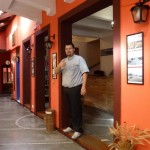 |
 |
 |
 |
My hotel Pousada Dona Zilah is located in Jardim Paulista three blocks from Av Paulista, a 2.8 km avenue lined with sky-crappers, which was once the symbol of Latin America’s 20th– century business aspirations. Jardim area refers to the wealthy and leafy neighbourhoods. I paid 196 Real a night in this pousada which is atmospheric. My room is small with a ceiling fan. It was hot and humid. Rain poured down after 10pm. It was cooler and I had a nice sleep with the windows open.
December 29 – 31 Sunday – Tuesday: São Paulo 
It gets bright before 6am and I often sleep only for five to six hours. I intended to make a trip to Paraty, a well-preserved colonial town by the coast about 6 hours´ drives from São Paulo. But there was no seat available till January 1. Hence I was stuck for three days in São Paulo with over 11 million people, the largest city and a business hub in the continent. It is not a touristic city and I did not do much as the museums and galleries were mostly closed. As a result, I spent a few hours each day exploring several neigbhourhoods on foot.
On Sunday, I began with the old city, the area lying between Praςa da Sé, Luz metro station and Praςa da República. I first took the metro from Consolaςon to Luz and walked to the Mercado Municipal, one of the city´s landmarks. The area around the market is vibrant with shoppers but dirty and run-down.
 |
 |
 |
 |
The market is a foodie’s dream and a tourist attraction. It is atmospheric: a magnificent colossal building, colourful stalls with fresh fruits, dried meat, herbs, wine and cheese. There are also dozens of eateries. Somehow, the rich smell of meat, cheese and fried food put me off and I lost my appetite.
After the market, I followed the flow of people and started going uphill as I saw a huge green dome in a distance. I found my way through winding roads and arrived at the site where São Paulo was founded in 1554. The Pátio do Colégio was inaugurated by the Jesuits. In the middle of the square is a pillar named Glória Imortal aos Fundadores de Sáo Paulo commemorating the occasion with three groups namely the Jesuits, the Portuguese and the natives that were responsible for founding the city. The square is surrounded by three majestic buildings with orange yellowish hue belonging to the Justice Secretariat.
 |
 |
 |
I then arrived at the magnificent Catedral Metropolitana one of the largest Gothic churches in the world at Praςa da Sé. The Sunday mass was in progress and I sat down listening to the soothing voice of the preacher and the choral singing.
 |
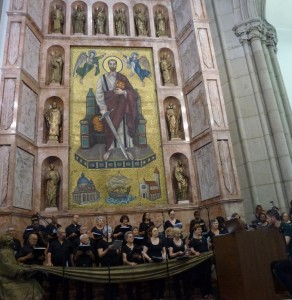 |
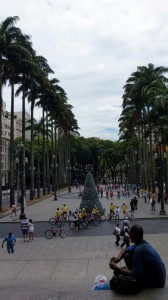 |
Earlier Japanese emigrants coming in 1913 have settled around Liberdade. Today this Japanese town is a tourist spot with a big Sunday market drawing in a large crowd. The place is too noisy and crowded for me.
I left and took the metro to the Eldora Mall to see whether I could get a cheap air ticket to Brasilia, the capital. (In the morning, the receptionist of the hotel found a cheap return ticket online to Brasilia for 262 Real. But as I am not a citizen with an ID, I was unable to buy the ticket. Instead, I was advised to go to TAM office in the mall to get a ticket). When I got there, TAM told me that the return ticket would cost 835 Real! It is too expensive and I drop the idea. I found a money changer in the mall and got almost 2.3 Real for one US dollar. No commission!
On Monday (Dec 30), I took the metro to Portuguese-Tiete to buy a bus ticket to Paraty on January 1. The bus station is said to the largest in the continent and is well-organised and efficient. I then took the metro to Vila Madalena known for its bohemia atmosphere and hoped to visit some galleries. Unfortunately all shops and galleries were closed. I strolled around the leafy area, had lunch in a Japanese restaurant and walked all the way back to the hotel. I got there at 4pm.
 |
|
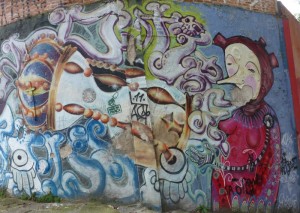 |
 |
It was humid and hot. After a shower and a rest, I walked to Av Paulista the venue for the New Year Eve celebration. I watched rehearsals and could feel their excitement.
Today (Dec 31) was New Year Eve. I had naively thought some museums might be opened though the hotel receptionist warned me they might be closed. I walked to Av Paulista for the metro and saw hundreds of runners getting ready for the São Paulo marathon. I was told some 30,000 runners had taken part.
 |
 |
Kamyla has suggested me to visit the Museu Afro-Brasil in Parque do Ibirapuera. I have seen a number of museums in Africa about slavery and how the African were shipped off to the new world. So I want to see their stories here. Before going to the museum, I went to the bus station at Funda to buy a bus ticket for Campo Grande on January 5. The 14-hour journey cost 162 Real.
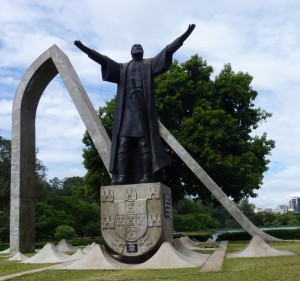 |
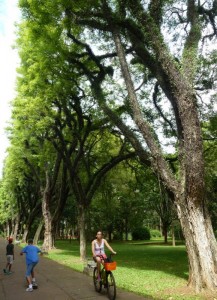 |
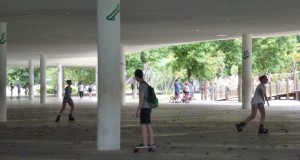 |
 |
I took the metro to Brigadeiro and had a pleasant 4-km walk to the Ibirapuera Park which resembles Central Park in New York. But all the museums were closed. It was hot and I walked all the way back to Paraiso to take a metro to Trianon-MASP. I was disappointed to find MASP (Museu de Arte de São Paulo) closed from December 30, 2013 to January 2, 2014. I walked back to the hotel. The city was empty as most of the shops and restaurants were closed.
It had been a futile day. Then the Wifi at the hotel went off in the afternoon. So I packed up and took a nap. I got up in the evening, left the hotel after 9pm and spent an hour in the IBIS Hotel lobby using its free Wifi to send out New Year card to family and friends. Then I joined over 100,000 locals standing in Av Paulista to welcome in 2014. The singers were good and the crowd was dancing, singing and swaying their hips. I found a good spot opposite HSBC to stand but the strong smell of body, sweat, food and urine upset my stomach. Fortunately I did not vomit. I stood for over an hour and a half (I had never done this before) watch the thong of people swarming past and the cheerful crowd. All were enjoying this special occasion. Then the countdown began and the firework lightened the sky. We had better fireworks in Hong Kong but the mood here was filled with happiness and excitement. Felix Ano Novo (Happy New Year!)
January 1- 3, Wednesday – Friday: Paraty
The first Portuguese arrived in Paraty in the late 16th century. On Feb 1667 the village of the present day Paraty was recognized. In the late 17th century, an Indian trail started to be used to the flow of gold and precious stones mined from Minas Gerais. This path has been known as “Estrada Rea”. Major construction of churches began and the village took shape. Paraty was almost forgotten after being isolated from the trade routes of the country. As a result, its culture, architecture, buildings, streets and traditions have been preserved.
I took the 9am bus on New Year Day to Paraty. Mary and Louise, two sisters in their 60s from America sat next to me and we had a nice chat. The road along the coast was blocked as many Brazilians came here for holiday. The bus arrived at the bus station around 3:30pm. Mary and Louise invited me to join them for dinner at Café Margarita at 7pm the following day. I immediately brought a return ticket leaving Paraty at 11pm on January 3. In this way, I would not waste my daytime on the road and could spend more time in both Paraty and São Paulo.
 |
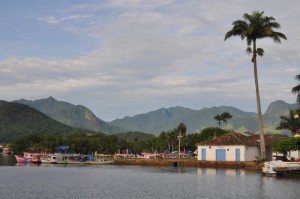 |
 |
 |
The old town is small with six main streets stretching from River Pereque-Acu to the east and a stream to the west and another six streets between the sea to the south and Domingos Goncalves de Abreu to the north. Many of the old houses have become guest houses or pricy hotels, cafes and souvenir shops.
I had some difficulties in finding accommodation. The good pousadas charge over 400 Real and were all full. A hostel bed would cost about 40 Real but I wanted something more decent on New Year Day. At the end, I found a single room in Casa da Colônia built in 1758 for 150 Real a night.
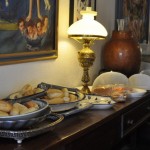 |
 |
 |
 |
Once I found a roof, I rushed out to see this lovely town filled with picturesque white-washed buildings and churches in colonial architecture. I also booked a jeep tour to three waterfalls for 70 Real with Eco Turisimo. In return, I had a free boat trip to four beaches on January 3, Fantastic deal!
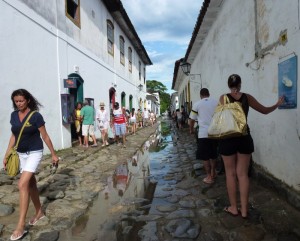 |
 |
 |
 |
After a good night sleep, I got up around 6am and began exploring the sleepy town on foot. I took plenty of pictures without people!
 |
 |
 |
 |
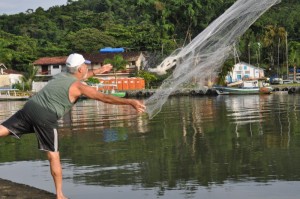 |
 |
 |
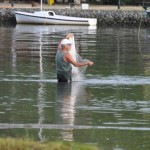 |
 |
 |
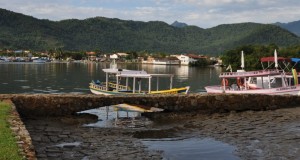 |
I joined the jeep tour at 11am. After 5 minutes, I realized I had left the safe with my passport and money in my room unlock. I got worried and wanted to return to the casa to lock the safe. The driver understood my anxiety and offered to take me back to my casa after taking the group to the first waterfall. He did and I appreciated his initiative and kindness. When I gave him a tip of 10 Real at the end of the tour for his help, he was moved.
 |
 |
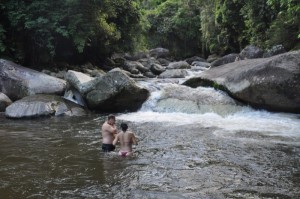 |
|
We had lunch at the second spot featuring a natural rocky water slide and many levels of waterfalls. There are however too crowded and noisy. The third spot with a gigantic white rock was lovely with only a dozen visitors. In this tour, I met four young Brazilians namely Anna, Bia, Mario and Terrence. Mario who speaks English kept me informed of what´s happening.
In the evening, I met up with Mary and Louise who have brought a holiday home near the old town. We had a wonderful time finding out each other´s past. They are lovely and kind people. Before leaving, they invited me to visit their place around 8am the following day.
 |
Most people coming here would stay up late and get up late. I still go to bed around 10pm and got up at 6am. On my last day in Paraty, I strolled around the town at 6:30am. The streets were flooded as a result of high tide. The reflections of houses were beautiful.
 |
 |
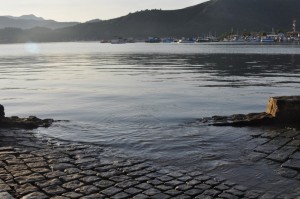 |
 |
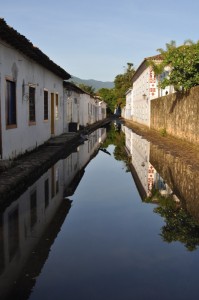 |
 |
Then I made my way to the home of the American sisters. Their two-bedroom unit just outside the old town facing the river has excellent views of the mountains and the river. The walls in their flat are filled with paintings. I showed them my website and my thoughts on developments in Africa as they are planning a trip to Ghana to study the effect of education on girls in rural areas. They invite me to return to stay one day. I gladly accepted their kind offer.
 |
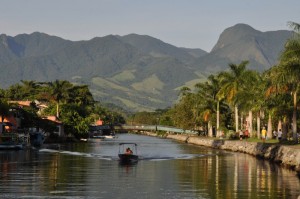 |
 |
 |
At 11am, I was on board the boat Rei Felip I with some 100 day-trippers. It was too crowded. There are over 60 islands with lovely beaches just off Paraty. The boat stopped in four beaches. Each time, there were at least 6 to 7 boats of similar size in the bay. I do not enjoy this type of boating at all and was glad to be back to the pier at 6:30pm.
 |
 |
 |
 |
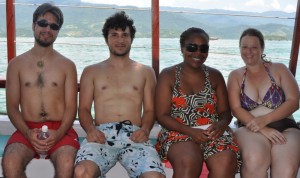 |
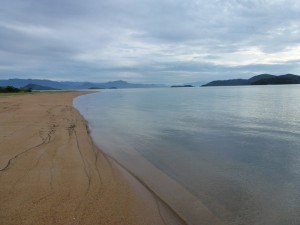 |
 |
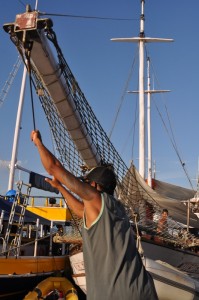 |
I had a good dinner, took a shower and then went to the bus station before 9:30pm. The bus set off at 11pm and I arrived in São Paulo at 4:30am on January 4.
 |
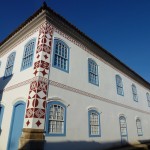 |
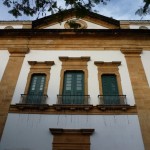 |
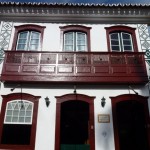 |



